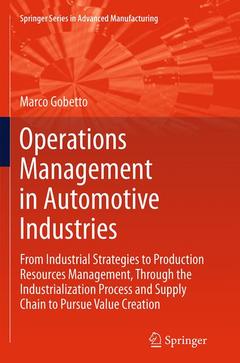Description
Operations Management in Automotive Industries, Softcover reprint of the original 1st ed. 2014
From Industrial Strategies to Production Resources Management, Through the Industrialization Process and Supply Chain to Pursue Value Creation
Springer Series in Advanced Manufacturing Series
Author: Gobetto Marco
Language: English
Subjects for Operations Management in Automotive Industries:
Publication date: 08-2016
Support: Print on demand
Publication date: 11-2013
245 p. · 15.5x23.5 cm · Hardback
Description
/li>Contents
/li>Biography
/li>Comment
/li>
Foreword.- About the author.- Introduction.- Acknowledgements.- 1 Historical Outlines and Industrial Strategies for Automotive Industries.- 1.1 Historical Outlines in Automotive Industries.- 1.2 Strategic Planning of Production Activities.- 1.3 Process Integration and “Make or Buy” Decision Making.- 1.4 Manufacturing Systems’ Set-Up and Location Criteria.- 1.5 Technologies for Materials Applied to Vehicles’ Construction Overview.- 1.6 Sketches for Manufacturing Systems Adopted in Cars Manufacturing.- 1.7 Systems’ Strategical Prerogatives.- 2 From project to product.- 2.1 Standardization Logics and Project Setting Up.- 2.2 Industrialization Process Description.- 2.3 Product/Process Information Technology System.- 2.4 Product Composition Analysis.- 2.5 Product Technical Changes Management.- 3 Manufacturing Engineering and Equipment Efficiency Evaluation.- 3.1 Manufacturing Engineering Planning and Executive Project.- 3.2 Production Capacity Setting.- 3.3 Working Time Analysis Methodologies.- 3.4 Man/Machine Interaction and Standard Working Time Defining.- 3.5 Equipment Times Deployment Diagram.- 3.6 Integrated Production System Introduction.- 3.7 Operative Productivity and Flexibility.- 3.8 Equipment and Machine Loading.- 3.9 Installed Productive Capacity Defining.- 4 Work Analysis and Labour Productivity Evaluation Criteria.- 4.1 Activity Level and Labour Efficiency.- 4.2 Manpower Planning.- 4.3 Working Time Length and Flexibility.- 4.4 Labour Productivity and Improvement Plans.- 4.5 Input Data for Operative Control.- 4.6 Tasks Assignment and Workload Balancing.- 4.7 Production Employees Motivation and Rewarding.- 5 Manufacturing System Management and Maintenance Criteria.- 5.1 Plant Manufacturing System.- 5.2 Equipment Reliability and Maintainability.- 5.3 Maintenance Management.- 5.4 Costs and Maintenance Effectiveness Correlation.- 5.5 General and Complementary Equipment for Production.- 5.6 Tools and Consumables Management.- 5.7 “Total Productive Maintenance” approach.- 6 Logistics and Supply Chain Basics for Automotive Application.- 6.1 Logistics Historical Evolution and Actual Strategies.- 6.2 Logistics Flows in the Supply Chain.- 6.3 Material Handling and Inventory Management Methodologies.- 6.4 Production and Delivery Planning.- 6.5 Logistics Information Technology Systems.- 6.6 Logistics Key Performance Indicators.- 7 Global Purchasing Operations.- 7.1 Purchasing Department’s Role.- 7.2 Purchasing Policies Evolution.- 7.3 Purchasing Marketing and Global Sourcing Policies.- 7.4 Suppliers Network Management.- 7.5 Order Procedure and Cooperation Agreements.- 7.6 Supplying Cost and Purchasing Effectiveness Indicators.- 7.7. “E-Procurement” Techniques.- 8 Quality Management and Continuous Improvement.- 8.1 The “Learning Curve” Concept.- 8.2 Production Ramp Up and Maximum Rate Achievement.- 8.3 Quality Management in Industrial Processes.- 8.4 Quality and Reliability Assurance Techniques in Product Design Phase.- 8.5 “Total Quality Management” and Continuous Improvement Approach.- 9 Value Creation and Final Considerations.- 10 (APPENDIX) Production Management Basics.- 10.1 The Product.- 10.2 Production Systems.- 10.3 Criteria for the Stock and Lots Management.- 10.4 Problems Connected to the Planning Horizon.- 10.5 APP (Aggregated Production Planning).- 10.6 MPS (Master Production Schedule).- 10.7 MRP (Material Requirement Planning).- List of Abbreviations.
Marco Gobetto was born in Rimini (RN, Italy) in 1967 and took his master’s degree in Electronic Engineering in 1993 at Politecnico of Turin.
He currently holds positions as Manufacturing Training Unit Manager at FIAT Sepin S.c.p.A. and Professor at the Faculty of Automotive Engineering. He has taught courses in both Production Management and Production Processes, Safety, Organization and Management.
After having complete his University studies, he began his professional career at FIAT Auto S.p.A. in the Manufacturing Engineering Department, as part of the Style Design Manufacturing Analysis Team. From there he proceeded to the position of Body in White Process Engineer, contributing to the production launches of two new cars in Italy and then coordinating industrialization activities in Poland for a new body in white model.
In 1998 he moved to Ferrari S.p.A. as Body in White Plant Manager at the “Carrozzeria Scaglietti” facility in Modena.
In 2000 he left FIAT to assume responsibility for the Manufacturing Engineering Department at Carrozzeria Bertone S.p.A. in Grugliasco (TO,, Italy). {AU: PLEASE CONFIRM “TO,,” IT IS OK, IT STANDS FOR “TORINO PREFECTURE” } In two years, three new models of vehicles were launched and, for the first time in Bertone history, second and third shifts in production were activated.
At the beginning of 2002 he rejoined the FIAT Group at ISVOR FIAT S.c.p.A. where he specialized in Total Productive Maintenance and Continuous Improvement training programs, following on IVECO and FIAT Powertrain sectors. He subsequently coordinated international training initiatives for a joint venture in India between FIAT and TATA. In 2007 he assumed responsibility for the Manufacturing, Quality and Product Development Training Area that, at the end of 2008, became the central Manufacturing Training Unit in the new training organization in FIAT, thereby contributing to all initiatives worldwide both in FIAT and Chrys
Has proven its worth in class use already
Good resource to serve as introduction to topic
Written by world leading expert
These books may interest you

Basics of Supply Chain Management 214.69 €



